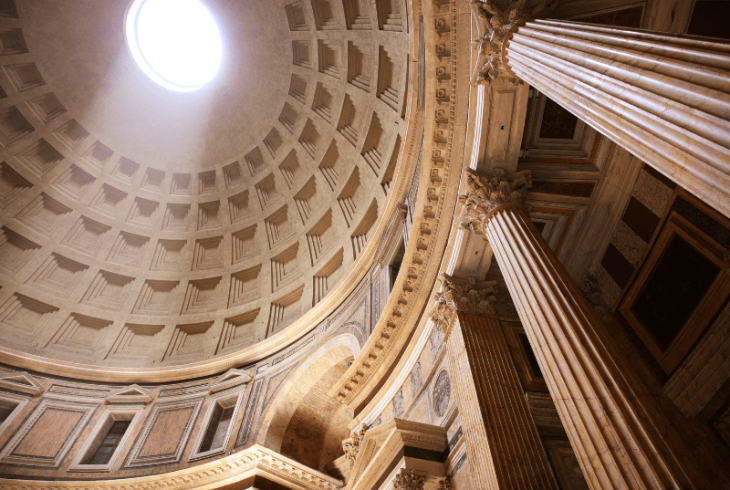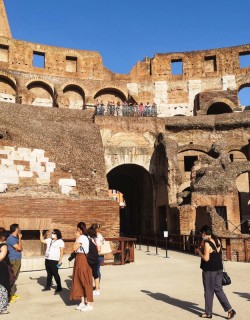When the architecture-mad Pope Urban VIII ascended to the papacy in the early 17th century, he ordered an inscription to be chiseled into the entrance porch of the iconic Pantheon in Rome. In it, he lauded the venerable ancient temple as “the most celebrated edifice in all the world.”
Ironically, despite his justifiable awe, Urban was also guilty of plundering the Pantheon for its precious bronze, which he had melted down and recast as cannons. Nonetheless, the two-faced old Pope had a point! No building in the world has had a bigger influence on the history of western architecture than the fabulously beautiful Pantheon, and whenever I’m hosting friends and family in Rome it’s the very first place we go to visit.
In an earlier online guide we’ve detailed exactly why you need to visit the Pantheon and how to do so, including answering all your questions about the new ticketing system. This week we’re taking a look at ten things you need to see when you get to the Pantheon!
The Pantheon Fountain
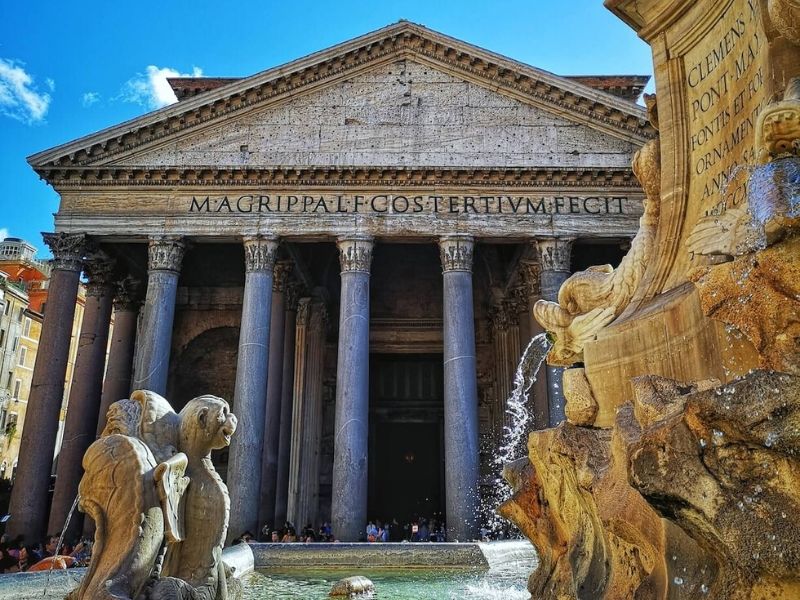
Dazzled by the extraordinary form of the Pantheon, it’s tempting to not give the fountain that stands at the center of Piazza della Rotonda a second glance. But before entering the Pantheon, tear your eyes away from antiquity’s greatest temple to admire what has to rank as one of the most beautiful fountains in Rome.
Surrounded by angry looking dolphins and theatrical masks spewing jets of water, a rocky pedestal supports an Egyptian obelisk, erected here on the orders of Pope Clement XI in 1711. The fountain was originally designed by Giacomo della Porta in the 1570s, however, and brought water to the area via the restored Acqua Vergine aqueduct - a key moment in the development of modern Rome.
The Pediment Inscription
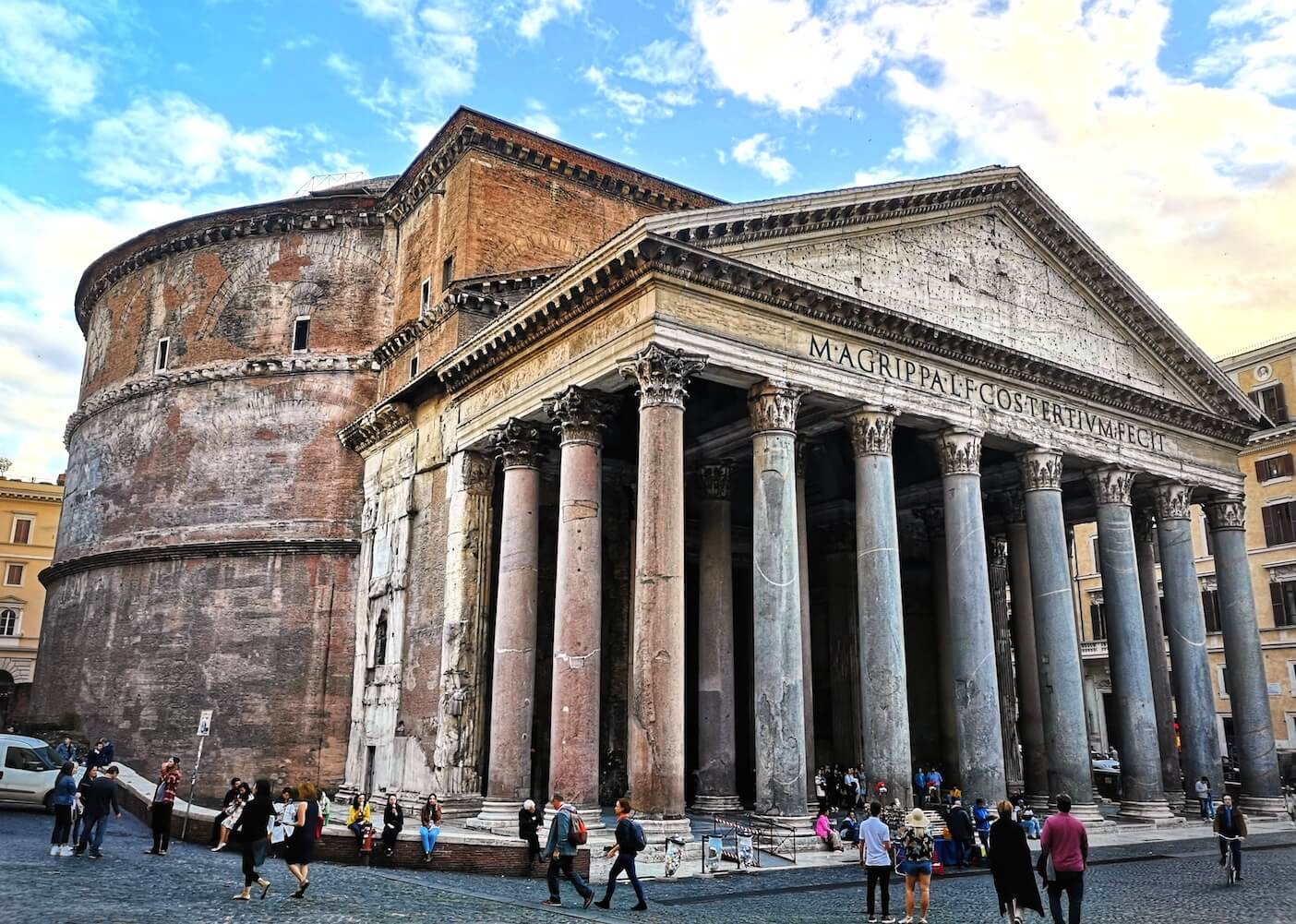
Whilst in Piazza della Rotonda, make sure to look up at the massive, pockmarked triangular pediment that dominates the Pantheon’s facade. The holes were made by drilling in massive metal clamps to hold up the gleaming marble sheets that once adorned the pediment - long since plundered and reused in other Roman building projects after the fall of the ancient empire.
An inscription on the pediment records the following in massive letters: "M·AGRIPPA·L·F·COS·TERTIVM·FECIT." That is, ‘Marcus Agrippa, son of Lucius, consul for the third time, built this.’
Marcus Agrippa was a Roman general and close friend of the Emperor Augustus, and was responsible for the construction of the first Pantheon as part of his duties as Consul around 27-25 BC. The inscription is somewhat misleading, however, as the structure we see today was actually rebuilt by Emperor Hadrian around 150 years later after the original was damaged by fire. In an act of respectful homage,, the emperor saved and reused the original inscription crediting Agrippa when he had the temple rebuilt.
The Portico Columns
The portico of the Pantheon is supported by 16 massive Corinthian columns, each standing almost 40 feet tall, divided into three receding rows. The columns were quarried in the quarries of Mons Claudianus in the eastern desert of faraway Egypt. This region was renowned for its high-quality gray and pink granite, which was highly prized by the Romans for monumental construction.
The shafts are monolithic, meaning each column was carved from a single piece of stone. The mind-bogglingly enormous task of transporting these 40-foot monoliths from Egypt to Rome involved moving them down the Nile to Alexandria, then across the Mediterranean Sea, and finally up the Tiber River to their final destination. It was a truly extraordinary feat of logistical planning and engineering knowhow that seems almost impossible to contemplate without modern technology.
The Bronze Doors
The monumental bronze doors of the Pantheon stand nearly 24 feet tall, and are among the largest doors to survive from antiquity. The doors are formed of huge bronze sheets laid over a wooden structure, and most scholars believe them to date from Emperor Hadrian’s building campaign. Whilst the bronze is widely considered original, we’re less certain about the wooden interiors, which may have been replaced in the Middle Ages. Despite their massive size, the doors are so well-balanced that they can be easily pushed open by a single person.
The Dome
Make your way through the bronze doors and have your breath well and truly taken away by the awe-inspiring scale of the dome that tops the Pantheon. The dome of the Pantheon spans fully 142 feet in diameter, making it the largest unreinforced concrete dome in the world even to this day.
Weighing in at a mind-boggling 4,535-tonnes, it demonstrates the advanced skill and confidence of ancient Roman engineering better than any other structure. The dome forms a perfect hemisphere - its diameter and height are the same - helping to create an harmonious and balanced interior space that embodies the Romans' sophisticated understanding of geometry.
To enable them to build on such a gargantuan scale, Roman engineers deployed advanced construction techniques that saw them using progressively lighter materials as the dome ascended. At the base, the concrete was mixed with heavy travertine, while at the top, pumice - a much lighter volcanic rock - was used. This massively reduced the stress that the dome placed on the building.
The dome’s interior features a series of five rows of 28 coffers each. Besides being decorative, these sunken panels serve to reduce the weight of the dome without compromising its structural integrity. In a subtle perspectival trick each coffer diminishes in size as it approaches the oculus, making the dome seem even higher than it is.
The Oculus

Right at the top of the Pantheon’s dome is perhaps the building’s most iconic feature: this is the oculus, a circular opening in the roof that allows natural light to enter the building in great dramatic shafts of sunlight. Like the coffering of the dome, the oculus was another ingenious way for the Roman engineers to lighten the massive load of the edifice, ensuring its structural stability.
The oculus, which means eye in Latin, also performed a more complex symbolic function. Each year on April 21st, the day on which Rome was founded according to ancient legend, the midday sun passes over the oculus sending a beam of raking sunlight across the interior of the temple and out of a grille above the entrance doors. It’s been theorised that the emperor would arrive at that exact moment to celebrate Rome’s birthday in the Pantheon, bathing him in light and thus linking him indelibly to the divine power of the celestial realm.
Raphael’s Tomb
"Here lies that famous Raphael by whom Nature feared to be conquered while he lived, and when he was dying, feared herself to die."
Raphael, the great Renaissance artist known to contemporaries as the "prince of painters," died on Good Friday in 1520 at the age of 37. He was struck down by a fever, as he completed his final masterpiece, the Transfiguration, which you can now see in the Vatican Museums.
As he lay dying, the stricken artist made one final request: that he be buried in the Pantheon, a building that for him expressed the pinnacle of human creative achievement. Massive crowds attended his funeral, and four cardinals carried his bier to Rome’s greatest ancient temple. The Pope himself kissed Raphael’s hand, and the artist was laid to rest in a grand tomb surmounted by an elegant sculpture of the Madonna by the artist Lorenzetto. When visiting the Pantheon, make sure to pay your respects!
The Royal Tombs
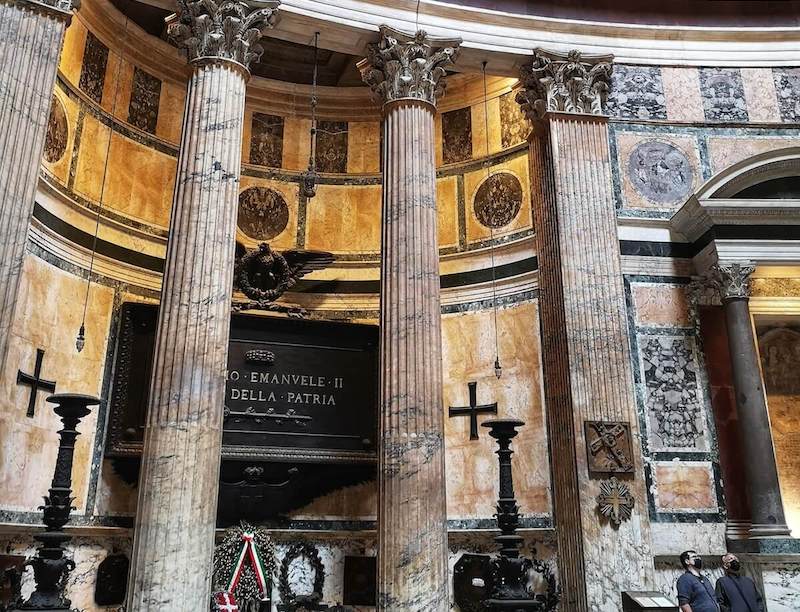
Raphael was a trend-setter when it came to choosing the Pantheon as his final resting place. After the unification of Italy in the nineteenth century, the first kings of the new nation followed in the great painter’s footsteps by choosing to be buried here too.
When visiting the Pantheon, you’ll see the massive tombs of King Vittorio Emanuele II and King Umberto I inside. The former is commemorated as “Padre della Patria,” or “Father of the Homeland,” on his enormous sarcophagus, whilst the latter is buried alongside his wife Queen Margherita of Savoy - inspiration for the Pizza Margherita invented in Naples during her husband’s reign.
The Byzantine Icon
![]()
The Pantheon was converted into a Christian church during the pontificate of Boniface IV at the beginning of the 7th century, and you can still see a holy object that was installed in the newly sacred space shortly after its Christanization. This is a Byzantine icon portraying the Virgin Mary holding the Infant Christ. Although we don’t know exactly when the icon was made, we know that it was in the church in the year 770, when a renegade priest who took refuge in the Pantheon after a failed seditious plot was recorded as clutching it to his body for protection.
The Marble Floor

When in the Pantheon, it’s inevitable that your eyes will be drawn always upwards towards that iconic dome; but make sure to take a look at the ground beneath your feet too! The Pantheon boasts a magnificent floor, still the ancient Roman original, decorated with colorful marbles, precious purple porphyry and granite arranged into patterns of circles and squares.
MORE GREAT CONTENT FROM THE BLOG:
- How to Visit the Pantheon in Rome
- 9 Things You Need to Know About the Pantheon in Rome
- Who is Buried in the Pantheon?
- The Best New Tours of Italy in 2024
- How to Visit the Colosseum in 2024
- Where to Stay in Rome in 2024: Areas and Hotels Guide
For over 20 years, Through Eternity have been organizing itineraries showcasing the best of Rome led by our resident expert guides. If you're planning a visit to the Eternal City this Spring, be sure to get in touch to help plan your perfect trip!
